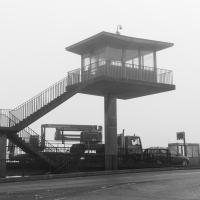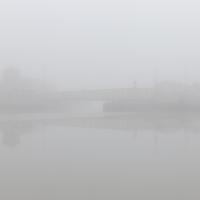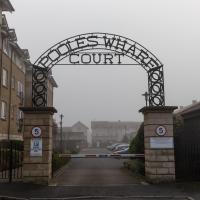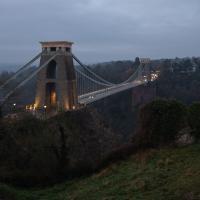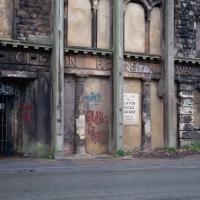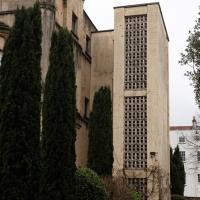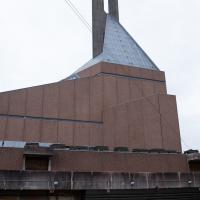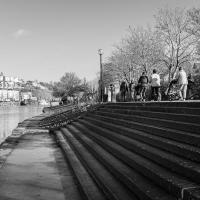Tagged: city
A Little Local Wander
07 Jan 2021
Which included a literal "local", the Pump House, to try out their shop/deli/cafe. A flat white, some apples and a New York Deli toastie. Eleven quid, mind, but the Pump House was never a cheap pub...
I enjoyed the fog, and wandering down a few more out-of-the-way back alleys and what-have-you on the Hotwell Road.
I'm thinking of getting up early and going for a morning walk tomorrow, weather-depending, but at the moment my motivation to do things like this seems to be much strong in the evenings when I'm just thinking about it rather than in the morning when I actually have to do it. But it's going to be cold, and low tide is quite early, so there's always a chance of getting some footage of the hot well actually being visibly hot; you never know...
Is "knts" really a helpful abbreviation for "knots"? It's not like there wasn't room for the "o"...
It's a private estate, but I figured nobody would object too much if I wandered straight through. I don't push my way into private areas too much on these walks—my intention in the first place was to only walk down public roads—but sometimes my curiosity about a place I've walked past for decades but never set foot on gets the better of me.
It helps, I'm sure, that I'm white, approaching middle age and have a vaguely RP accent. Plus I do my best to look as un-furtive as possible and only wander through private areas in broad daylight and carrying a big obvious camera, which might be helping rather than hindering. In all the years I've been walking around places and poking my nose in I've never been asked to leave anywhere, anyway, so I've been taking that as a sign that my hopefully-repectful approach is working.
I didn't walk into the private garden here, but it was nice to get a new perspective on this curved terrace I've walked past so many times on the way down the harbourside into town.
Morning Walk
08 Jan 2021
Tempted by a hopeful repeat of yesterday's weather, I got up early this morning and went for a short walk up into Clifton Village, around Observatory Hill, back down the Zig Zag and home. Instead of beautiful and mysterious fog and crisp freezing brightness I got some murk and slight dampness which included witnessing a road-raging van driver and finding that it still wasn't cold enough for the hot well to be even gently steaming when I got down there. I've still never seen it steaming, but I've been told it does, on colder days.
There are a few traditional vantage points for snapping the suspension bridge from Observatory Hill
I quite liked the colours and the light, but this photo doesn't really capture the feeling. Ah well.
The way the left-hand side looks a lot more together than the right-hand side may be explained by the very first part of the listing:
Rock House, now divided into 2. c1800. Render with limestone dressings, roof not visible. Double-depth plan. Late Georgian style. 3 storeys and basement; 5-window range. A symmetrical front has pilaster strips to a moulded coping, a wide basement area with Pennant-stepped bridge to an elliptical-arched doorway with metal batswing fanlight and 2-leaf 12-panel door with fluted lower panels. In front of the basement area is a later colonnade of 6 slim Tuscan columns, square to each end, to a deep first-floor balcony, and a shallow, tented second-floor balcony on cast-iron brackets with flat stanchions, both with pointed-arched wrought-iron railings with quatrefoils; 8/8-pane ground-floor sashes, French windows above, and plate-glass basement sashes.
However, I've found several references that suggest that even Historic England's estimate of the date of the property is wrong. I just found one in a planning document, part of an objection to a planning application related to Prince's Lane by the Cliftonwood and Hotwells Improvement Society:
Rock House (412 Hotwell Rd) is shown in an early engraving by William Halfpenny in 1731 so is much older than any of the neighbouring buildings and is the sole survivor of the original Hotwell Spa. It is incorrect to say it dates from 1800, and the planners have been told this.
I haven't, sadly, tracked down the engraving itself.
Mirror Maze
10 Jan 2021
Went for a wander with my friend Lisa—the current lockdown rules seem to be that one local walk for exercise per day with a maximum of one person not in one's "bubble" is fine—up to the University of Bristol area right at the edge of my one-mile perimeter to see the Jeppe Hein Mirror Maze, among other things. On the way we mused about Merchant Venturers, the slave and tobacco trades, and dating in the time of Covid.
It may say "Reflections House", but in its listing it's called "The White House". Charles Dyer, 1850.
I imagine it would look a lot nicer if it weren't backlit. Maybe I'll try taking another snap of it at a different time of day...
Northern Clifton
16 Jan 2021
A raggedy wander with my friend Lisa, picking up a few stray streets and venturing only briefly onto Whiteladies Road, where it was too damn busy, given the current pandemic. We retreated fairly quickly. Found a couple of interesting back alleys, and got a very pointed "can I help you?" from a man who was working in his garage in one of the rather run-down garage areas behind some posh houses, and clearly didn't want us just wandering around there.
Oddly, this is a little crescent that two-thirds Coddrington Place and one-third Belgrave Place, it seems
Birthday Coffee
21 Jan 2021
A quick jaunt to Clifton Village to grab a birthday coffee and cake (courgette, lime & pistachio, thanks for asking) from Twelve, and rubberneck at the demolition of the block that used to house the WH Smith, among other things. I remember the Havana Cafe, Mail Boxes Etc (for those who wanted a Clifton postcode without living there?) and others.
Coffee and Graff
22 Jan 2021
Took myself around the harbour to Imagine That's horsebox cafe and treated myself to a flat white and a sourdough cheese toastie. On the way there and back I encountered some local flooding and various bit of graffiti, from some ugly tagging on someone's front windows to a large new piece being added to Cumberland Piazza in the ongoing attempts to cheer the place up.
Just deep enough to be practically impassable, even in my waterproof Keens. I've not used this underpass to know if this is a regular occurrence or just the aftermath of Storm Christoph.
Because the main path seemed far too busy for the middle of a pandemic. I suppose I'm literally avoiding people like the plague.
Snowy Leigh Wander
24 Jan 2021
I started this wander with my "support bubble" Sarah and Vik, after Sarah texted me to say "SNOW!" We parted ways on the towpath and I headed up into the bit of Leigh Woods that's not actually the woods—the village-like part in between Leigh Woods and Ashton Court, where I'd noticed on a map a church I'd not seen before. I found St Mary the Virgin and quite a few other things I'd never experienced, despite having walked nearby them many, many times over many years, including a castellated Victorian water tower that's been turned into a house...
It's a lychgate and a war memorial. I read all the names, but the photos I took didn't really do them justice. Being there and reading them felt important, though, perhaps because in the book I'm reading, EH Young's Chatterton Square, the Second World War is about to start. The novel is set in a fictional Bristol and was written (I think) and published just post-war, in 1947, and she managed to give a very looming feeling to the upcoming conflict.
This memorial, though, is to the dead of the First World War. It's even possible that EH Young herself stood here and read it at some point. She describes at least one walk on this side of the bridge in Chatterton Square, and she lived in Bristol for quite some time.
Another Lunchtime, Another Quick Coffee Trip
28 Jan 2021
With very little photography, and no new streets. Still, I did manage to buy milk at the "Simple Cow" vending machine—and "simple" is very definitely false advertising; it took me bloody ages to work out how to use the thing—and snap the new ACER/SEPR piece down in Cumberland Piazza.
Unexpected Snow
31 Jan 2021
I just nipped out to post a blood test (not Covid-related) and check that my car was okay, because I've not driven it for weeks. I was just going to walk up to Clifton Village, but I spotted the opportunity to re-park the car on my street rather than up the hill around the corner where it was, so instead I got in, intending just to move a hundred metres, but it turned over slowly before it started, and then warned me that the battery was very low and I should go for a long drive to recharge it.
So, I did my best, zipping up the A4018 to the motorway junction and back again, dropping off my blood at a postbox along the way, and while I did that, it started snowing. I noticed it was low tide, too, so when I got back home I headed back out again, this time on foot and with a camera so I could see if I could find any evidence of the Hot Well steaming.
I saw not a single sign of the Hot Well steaming, but it was quite a nice quick outing and I enjoyed my brief walk in the snow. Iike Hinton Lane, too, and while it's all old ground I was re-treading, I did at least get a picture or two with a bit of snow and some of the cold winter atmosphere of the trip, I think.
Greville Smyth Path Completionism
02 Feb 2021
I needed to get away from my desk at lunchtime, and I saw a little segment of path in Greville Smyth Park that needed knocking off my "to walk down" list, so that gave me a target. Sadly Hopper Coffee's little Piaggio Ape wasn't there to sell me a coffee. I hope Rich is all right, not seen him so far this year.
Anyway, a fairly uneventful walk. They're putting new boundary fencing up around Hotwell Primary School (I wandered down Albermarle Row to see what the pneumatic drilling was about), the house on Granby Hill that's been covered in scaffolding and swaddled in protective sheeting has finally been revealed in its cleaned and refurbished form, and they were doing something to the flyover that leads up from the end of the Portway/Hotwell Road to the Plimsoll Bridge. Nothing much else to report.

